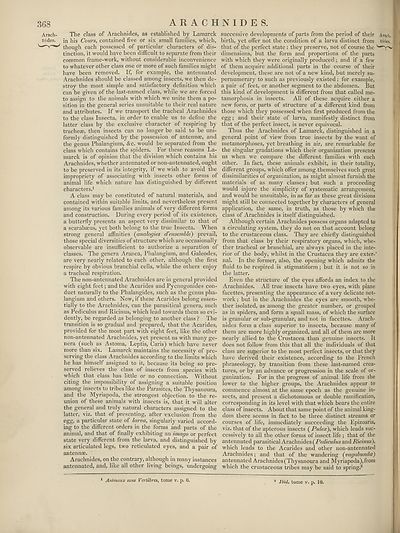Encyclopaedia Britannica > Volume 3, Anatomy-Astronomy
(376) Page 368
Download files
Complete book:
Individual page:
Thumbnail gallery: Grid view | List view

368 A R A C H
Arach- The class of Arachnides, as established by Lamarck
nides. in his Cours, contained five or six small families, which,
though each possessed of particular characters of dis¬
tinction, it would have been difficult to separate from their
common frame-work, without considerable inconvenience
to whatever other class one or more of such families might
have been removed. If, for example, the antennated
Arachnides should be classed among insects, we then de¬
stroy the most simple and satisfactory definition which
can be given of the last-named class, while we are forced
to assign to the animals with which we unite them a po¬
sition in the general series unsuitable to their real nature
and attributes. If we transport the tracheal Arachnides
to the class Insecta, in order to enable us to define the
latter class by the exclusive character of respiring by
tracheae, then insects can no longer be said to be uni¬
formly distinguished by the possession of antennae, and
the genus Phalangium, &c. would be separated from the
class which contains the spiders. For these reasons La¬
marck is of opinion that the division which contains his
Arachnides, whether antennated or non-antennated, ought
to be preserved in its integrity, if we wish to avoid the
impropriety of associating with insects other forms of
animal life which nature has distinguished by different
characters.1
A class may be constituted of natural materials, and
contained within suitable limits, and nevertheless present
among its various families animals of very different forms
and construction. During every period of its existence,
a butterfly presents an aspect very dissimilar to that of
a scarabseus, yet both belong to the true Insecta. When
strong general affinities (analogies d'ensemble) prevail,
those special diversities of structure which are occasionally
observable are insufficient to authorize a separation of
classes. The genera Aranea, Phalangium, and Galeodes,
are very nearly related to each other, although the first
respire by obvious branchial cells, while the others enjoy
a tracheal respiration.
The non-antennated Arachnides are in general provided
with eight feet; and the Acarides and Pycnogonides con¬
duct naturally to the Phalangides, such as the genus pha¬
langium and others. Now, if these Acarides belong essen¬
tially to the Arachnides, can the parasitical genera, such
as Pediculus and Ricinus, which lead towards them so evi¬
dently, be regarded as belonging to another class ? The
transition is so gradual and prepared, that the Acarides,
provided for the most part with eight feet, like the other
non-antennated Arachnides, yet present us with many ge¬
nera (such as Astoma, Leptis, Caris) which have never
more than six. Lamarck maintains the necessity of pre¬
serving the class Arachnides according to the limits which
he has himself assigned to it, because its being so pre¬
served relieves the class of insects from species with
which that class has little or no connection. Without
citing the impossibility of assigning a suitable position
among insects to tribes like the Parasites, the Thysanoura,
and the Myriapoda, the strongest objection to the re¬
union of these animals with insects is, that it will alter
the general and truly natural characters assigned to the
latter, viz. that of presenting, after exclusion from the
egg, a particular state of larva, singularly varied accord¬
ing to the different orders in the forms and parts of the
animal, and that of finally exhibiting an imago or perfect
state very different from the larva, and distinguished by
six articulated legs, two reticulated eyes, and a pair of
antennae.
Arachnides, on the contrary, although in many instances
antennated, and, like all other living beings, undergoing
N I D E S.
successive developments of parts from the period of their Araeh. :
birth, yet offer not the condition of a larva distinct from nides.
that of the perfect state : they preserve, not of course the
dimensions, but the form and proportions of the parts
with which they were originally produced; and if a few
of them acquire additional parts in the course of their
development, these are not of a new kind, but merely su¬
pernumerary to such as previously existed; for example,
a pair of feet, or another segment to the abdomen. But
this kind of development is different from that called me¬
tamorphosis in insects. All of these acquire either a
new form, or parts of structure of a different kind from
those which they possessed when first produced from the
egg; and their state of larva, manifestly distinct from
that of the perfect insect, is never equivocal.
Thus the Arachnides of Lamarck, distinguished in a
general point of view from true insects by the want of
metamorphoses, yet breathing in air, are remarkable for
the singular gradations which their organization presents
us when we compare the different families with each
other. In fact, these animals exhibit, in their totality,
different groups, which offer among themselves such great
dissimilarities of organization, as might almost furnish the
materials of as many classes; but such a proceeding
would injure the simplicity of systematic arrangement,
and would be unsuitable, in as far as these great divisions
might still be connected together by characters of general
application, the same, in truth, as those by which the
class of Arachnides is itself distinguished.
Although certain Arachnides possess organs adapted to
a circulating system, they do not on that account belong
to the crustaceous class. They are chiefly distinguished
from that class by their respiratory organs, which, whe¬
ther tracheal or branchial, are always placed in the inte¬
rior of the body, whilst in the Crustacea they are exter-*
nal. In the former, also, the opening which admits the
fluid to be respired is stigmatiform; but it is not so in
the latter.
Even the structure of the eyes affords an index to the
Arachnides. All true insects have two eyes, with plane
facettes, presenting the appearance of a very delicate net¬
work ; but in the Arachnides the eyes are smooth, whe¬
ther isolated, as among the greater number, or grouped
as in spiders, and form a spiall mass, of which the surface
is granular or sub-granular, and not in facettes. Arach¬
nides form a class superior to insects, because many of
them are more highly organized, and all of them are more
nearly allied to the Crustacea than genuine insects. It
does not follow from this that all the individuals of that
class are superior to the most perfect insects, or that they
have derived their existence, according to the French
phraseology, by transition from these last-named crea¬
tures, or by an advance or progression in the scale of or¬
ganization. For in the progress of animal life from the
lower to the higher groups, the Arachnides appear to
commence almost at the same epoch as the genuine in¬
sects, and present a dichotomous or double ramification,
corresponding in its level with that which bears the entire
class of insects. About that same point of the animal king¬
dom there seems in fact to be three distinct streams or
courses of life, immediately succeeding the Epizoaria,
viz. that of the apterous insects ( Pulex), which leads suc¬
cessively to all the other forms of insect life ; that of the
antennated parasitical Arachnides and Ricinus),
which leads to the Acarides and other non-antennated
Arachnides; and that of the wandering (vagabundce)
antennated Arachnides (Thysanoura and Myriapoda), from
which the crustaceous tribes may be said to spring.2
1 Animaux sans Vertehres, tome v. p. G.
2 iiirf. tome v. p. 10.
Arach- The class of Arachnides, as established by Lamarck
nides. in his Cours, contained five or six small families, which,
though each possessed of particular characters of dis¬
tinction, it would have been difficult to separate from their
common frame-work, without considerable inconvenience
to whatever other class one or more of such families might
have been removed. If, for example, the antennated
Arachnides should be classed among insects, we then de¬
stroy the most simple and satisfactory definition which
can be given of the last-named class, while we are forced
to assign to the animals with which we unite them a po¬
sition in the general series unsuitable to their real nature
and attributes. If we transport the tracheal Arachnides
to the class Insecta, in order to enable us to define the
latter class by the exclusive character of respiring by
tracheae, then insects can no longer be said to be uni¬
formly distinguished by the possession of antennae, and
the genus Phalangium, &c. would be separated from the
class which contains the spiders. For these reasons La¬
marck is of opinion that the division which contains his
Arachnides, whether antennated or non-antennated, ought
to be preserved in its integrity, if we wish to avoid the
impropriety of associating with insects other forms of
animal life which nature has distinguished by different
characters.1
A class may be constituted of natural materials, and
contained within suitable limits, and nevertheless present
among its various families animals of very different forms
and construction. During every period of its existence,
a butterfly presents an aspect very dissimilar to that of
a scarabseus, yet both belong to the true Insecta. When
strong general affinities (analogies d'ensemble) prevail,
those special diversities of structure which are occasionally
observable are insufficient to authorize a separation of
classes. The genera Aranea, Phalangium, and Galeodes,
are very nearly related to each other, although the first
respire by obvious branchial cells, while the others enjoy
a tracheal respiration.
The non-antennated Arachnides are in general provided
with eight feet; and the Acarides and Pycnogonides con¬
duct naturally to the Phalangides, such as the genus pha¬
langium and others. Now, if these Acarides belong essen¬
tially to the Arachnides, can the parasitical genera, such
as Pediculus and Ricinus, which lead towards them so evi¬
dently, be regarded as belonging to another class ? The
transition is so gradual and prepared, that the Acarides,
provided for the most part with eight feet, like the other
non-antennated Arachnides, yet present us with many ge¬
nera (such as Astoma, Leptis, Caris) which have never
more than six. Lamarck maintains the necessity of pre¬
serving the class Arachnides according to the limits which
he has himself assigned to it, because its being so pre¬
served relieves the class of insects from species with
which that class has little or no connection. Without
citing the impossibility of assigning a suitable position
among insects to tribes like the Parasites, the Thysanoura,
and the Myriapoda, the strongest objection to the re¬
union of these animals with insects is, that it will alter
the general and truly natural characters assigned to the
latter, viz. that of presenting, after exclusion from the
egg, a particular state of larva, singularly varied accord¬
ing to the different orders in the forms and parts of the
animal, and that of finally exhibiting an imago or perfect
state very different from the larva, and distinguished by
six articulated legs, two reticulated eyes, and a pair of
antennae.
Arachnides, on the contrary, although in many instances
antennated, and, like all other living beings, undergoing
N I D E S.
successive developments of parts from the period of their Araeh. :
birth, yet offer not the condition of a larva distinct from nides.
that of the perfect state : they preserve, not of course the
dimensions, but the form and proportions of the parts
with which they were originally produced; and if a few
of them acquire additional parts in the course of their
development, these are not of a new kind, but merely su¬
pernumerary to such as previously existed; for example,
a pair of feet, or another segment to the abdomen. But
this kind of development is different from that called me¬
tamorphosis in insects. All of these acquire either a
new form, or parts of structure of a different kind from
those which they possessed when first produced from the
egg; and their state of larva, manifestly distinct from
that of the perfect insect, is never equivocal.
Thus the Arachnides of Lamarck, distinguished in a
general point of view from true insects by the want of
metamorphoses, yet breathing in air, are remarkable for
the singular gradations which their organization presents
us when we compare the different families with each
other. In fact, these animals exhibit, in their totality,
different groups, which offer among themselves such great
dissimilarities of organization, as might almost furnish the
materials of as many classes; but such a proceeding
would injure the simplicity of systematic arrangement,
and would be unsuitable, in as far as these great divisions
might still be connected together by characters of general
application, the same, in truth, as those by which the
class of Arachnides is itself distinguished.
Although certain Arachnides possess organs adapted to
a circulating system, they do not on that account belong
to the crustaceous class. They are chiefly distinguished
from that class by their respiratory organs, which, whe¬
ther tracheal or branchial, are always placed in the inte¬
rior of the body, whilst in the Crustacea they are exter-*
nal. In the former, also, the opening which admits the
fluid to be respired is stigmatiform; but it is not so in
the latter.
Even the structure of the eyes affords an index to the
Arachnides. All true insects have two eyes, with plane
facettes, presenting the appearance of a very delicate net¬
work ; but in the Arachnides the eyes are smooth, whe¬
ther isolated, as among the greater number, or grouped
as in spiders, and form a spiall mass, of which the surface
is granular or sub-granular, and not in facettes. Arach¬
nides form a class superior to insects, because many of
them are more highly organized, and all of them are more
nearly allied to the Crustacea than genuine insects. It
does not follow from this that all the individuals of that
class are superior to the most perfect insects, or that they
have derived their existence, according to the French
phraseology, by transition from these last-named crea¬
tures, or by an advance or progression in the scale of or¬
ganization. For in the progress of animal life from the
lower to the higher groups, the Arachnides appear to
commence almost at the same epoch as the genuine in¬
sects, and present a dichotomous or double ramification,
corresponding in its level with that which bears the entire
class of insects. About that same point of the animal king¬
dom there seems in fact to be three distinct streams or
courses of life, immediately succeeding the Epizoaria,
viz. that of the apterous insects ( Pulex), which leads suc¬
cessively to all the other forms of insect life ; that of the
antennated parasitical Arachnides and Ricinus),
which leads to the Acarides and other non-antennated
Arachnides; and that of the wandering (vagabundce)
antennated Arachnides (Thysanoura and Myriapoda), from
which the crustaceous tribes may be said to spring.2
1 Animaux sans Vertehres, tome v. p. G.
2 iiirf. tome v. p. 10.
Set display mode to:
![]() Universal Viewer |
Universal Viewer | ![]() Mirador |
Large image | Transcription
Mirador |
Large image | Transcription
Images and transcriptions on this page, including medium image downloads, may be used under the Creative Commons Attribution 4.0 International Licence unless otherwise stated. ![]()
| Encyclopaedia Britannica > Encyclopaedia Britannica > Volume 3, Anatomy-Astronomy > (376) Page 368 |
|---|
| Permanent URL | https://digital.nls.uk/193762236 |
|---|
| Attribution and copyright: |
|
|---|---|
| Shelfmark | EB.16 |
|---|---|
| Description | Ten editions of 'Encyclopaedia Britannica', issued from 1768-1903, in 231 volumes. Originally issued in 100 weekly parts (3 volumes) between 1768 and 1771 by publishers: Colin Macfarquhar and Andrew Bell (Edinburgh); editor: William Smellie: engraver: Andrew Bell. Expanded editions in the 19th century featured more volumes and contributions from leading experts in their fields. Managed and published in Edinburgh up to the 9th edition (25 volumes, from 1875-1889); the 10th edition (1902-1903) re-issued the 9th edition, with 11 supplementary volumes. |
|---|---|
| Additional NLS resources: |
|

